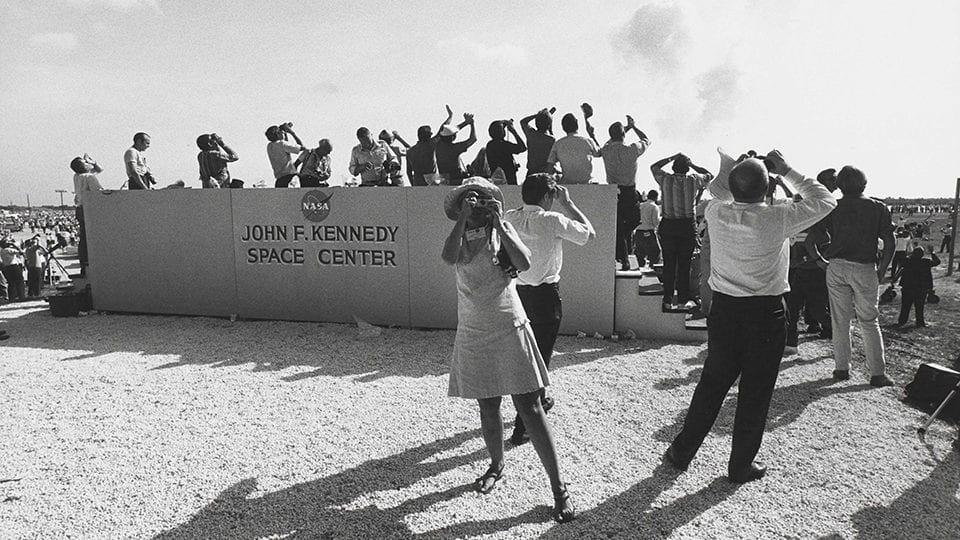Half a century has passed since man first set foot on the moon. To celebrate such a giant leap forward for mankind, the Museum of Fine Arts Houston has pulled together a selection of 40 photographs from its expansive collection, ranging from documentary images of NASA’s moon missions to cinematic interpretations of lunar phases. Within this groundbreaking show is a range of works that traverse different media and techniques, altogether evoking a sense of wonder and achievement whilst collecting a series of voices. Hitoshi Nomura’s “Moon” Score demonstrates differing qualities of light depending on its movements across the night sky. Cassandra C. Jones’s Wax and Wane stop-motion film is a welcome animation of the moon’s progress above various landscapes and natural backgrounds.
Highlights of the exhibition, however, are found in Garry Winogrand’s Apollo 11 Moon Launch, Cape Kennedy, Florida, 1969 (pictured above.) Spectators have their eyes, cameras and binoculars pointed toward the sky, intent on being witnesses to history in the making. It was captured just four days before humans landed the first spacecraft on the moon on 20 July, 1969. All but one woman face away from the camera, casting long shadows on the ground.
The show also features a 20×24 Polaroid print from David Levinthal’s Space, in which he stages mass-produced vintage American toys to create futuristic visions of space exploration. In this print, an astronaut floats outside his spaceship. The visual language is one borrowed from photojournalism or film, without referencing a particular moment in time or artistic inspiration. Instead, it solicits a response grounded in wider American consciousness.
Ansel Adams’ Moonrise, Hernandez, New Mexico, 1941, dramatically positions a shimmering white circle against the background of snow-tipped mountains. The image was taken during a six-month assignment for the Interior Department through western parts of the USA. The story goes that Adams was speeding down a highway in New Mexico after a fairly unsuccessful day of shooting when he spotted an “inevitable photograph” out of the corner of his eye, slammed on his brakes and rushed out of the car. He could not get a hold of his Weston exposure meter quick enough. The setting sun threatened to dim the white crosses in a graveyard within moments – the image gone forever. So he took a chance and calculated the luminance based on the intensity of the moon.
A number of museums, including the Metropolitan Museum of Art, New York, and the National Gallery of Art in Washington DC, are presenting similar shows about the landings. They come ahead of the first manned missions in five decades, taking place by 2024. The USA space agency also plans to send the first woman as part of the project, as well as the first sustained human presence, all by 2028.
Until 2 September. Find out more here.
Olivia Hampton
Lead image: Garry Winogrand, Apollo 11 Moon Launch, Cape Kennedy, Florida, 1969. Gelatin silver print, the Museum of Fine Arts, Houston, the Allan Chasanoff Photographic Collection. © The Estate of Garry Winogrand, courtesy Fraenkel Gallery, San Francisco.





